Abstract
Seasonal changes of daylength (photoperiod) affect the expression of hormonal and behavioral circadian rhythms in a variety of organisms. In mammals, such effects might reflect photoperiodic changes in the circadian pace-making system [located in the suprachiasmatic nucleus (SCN) of the hypothalamus] that governs these rhythms, but to date no functionally relevant, intrinsic property of the SCN has been shown to be photoperiod dependent. We have analyzed the temporal regulation of light-induced c-fos gene expression in the SCN of rats maintained in long or short photoperiods. Both in situ hybridization and immunohistochemical assays show that the endogenous circadian rhythm of light responsiveness in the SCN is altered by photoperiod, with the duration of the photosensitive subjective night under the short photoperiod 5-6 h longer than under the long photoperiod. Our results provide evidence that a functional property of the SCN is altered by photoperiod and suggest that the nucleus is involved in photoperiodic time measurement.
Full text
PDF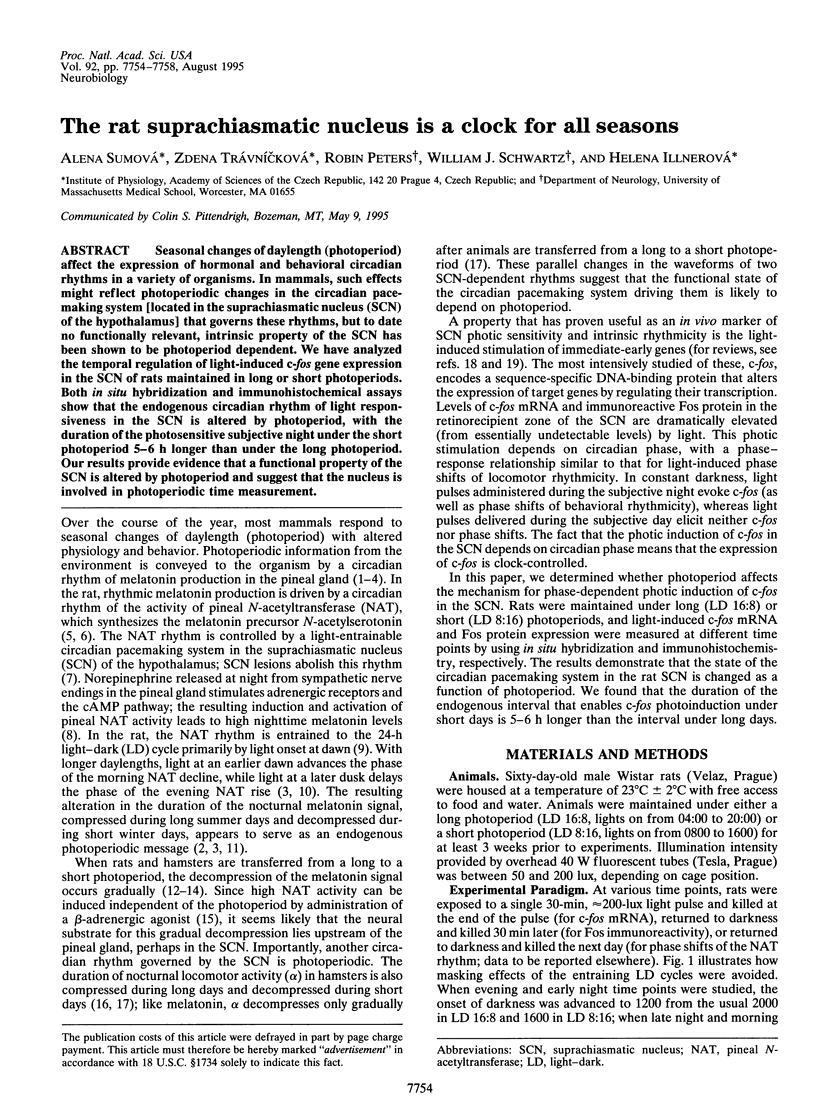
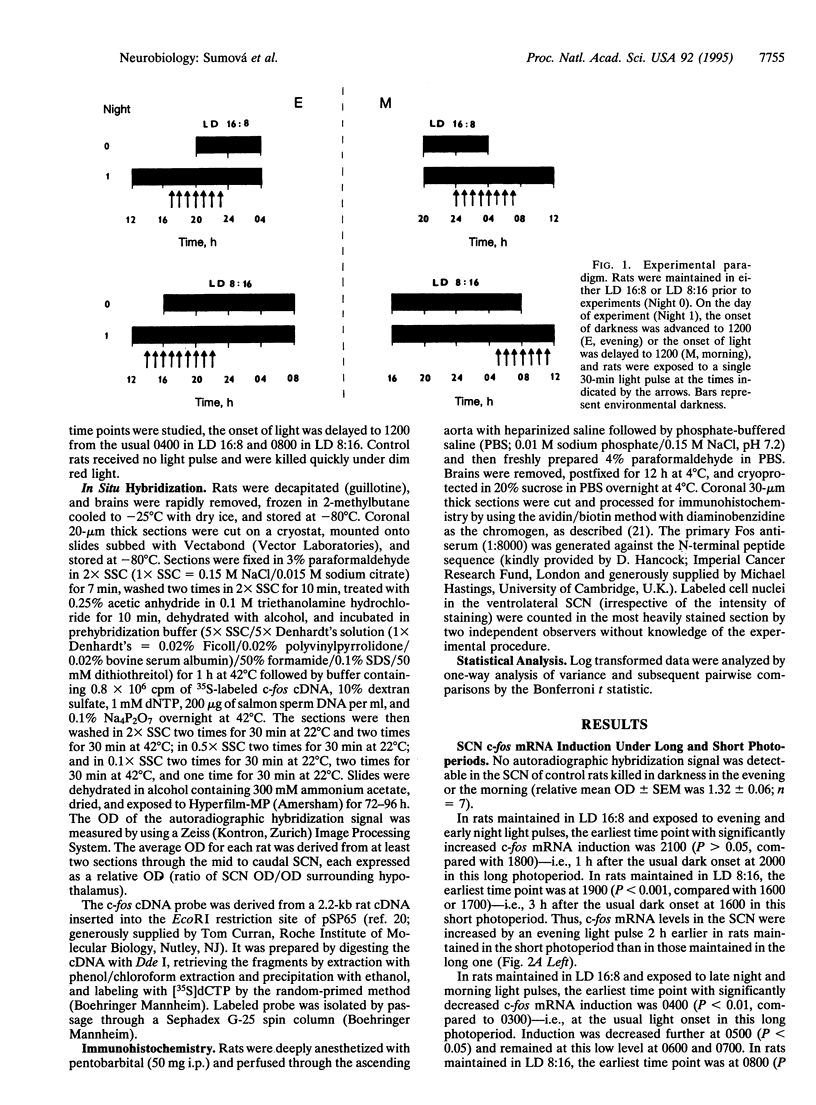
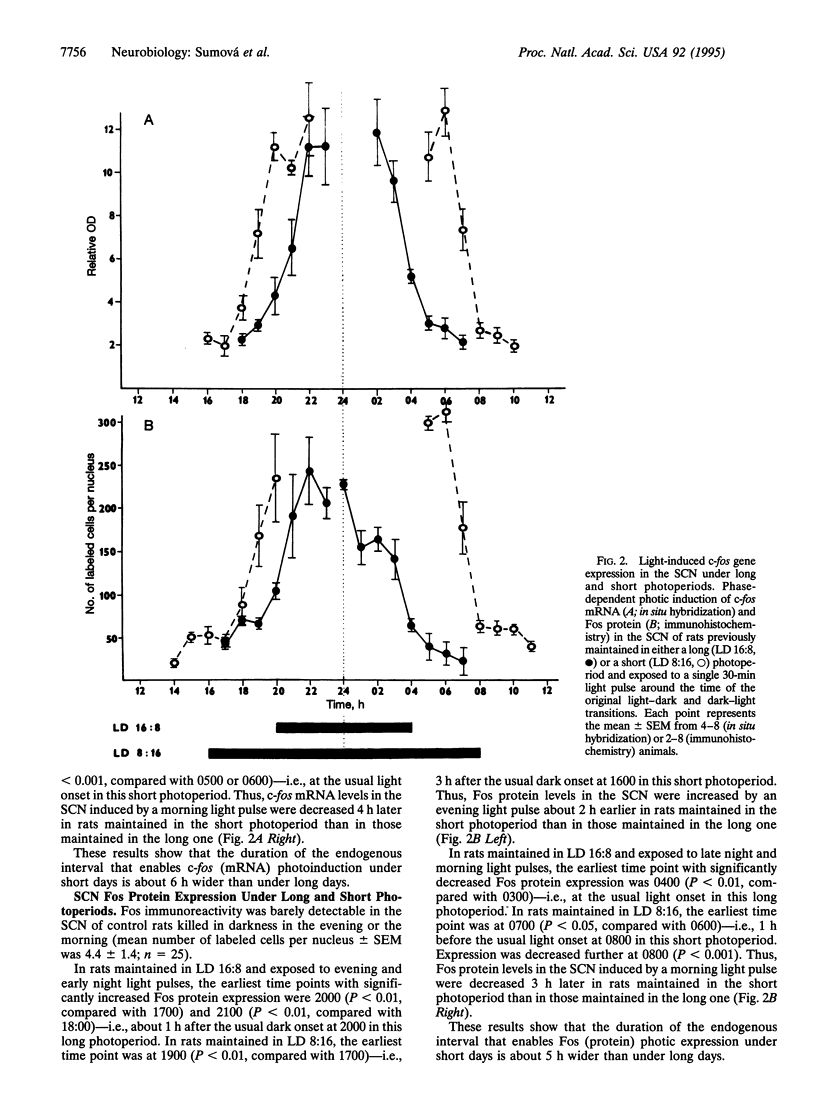
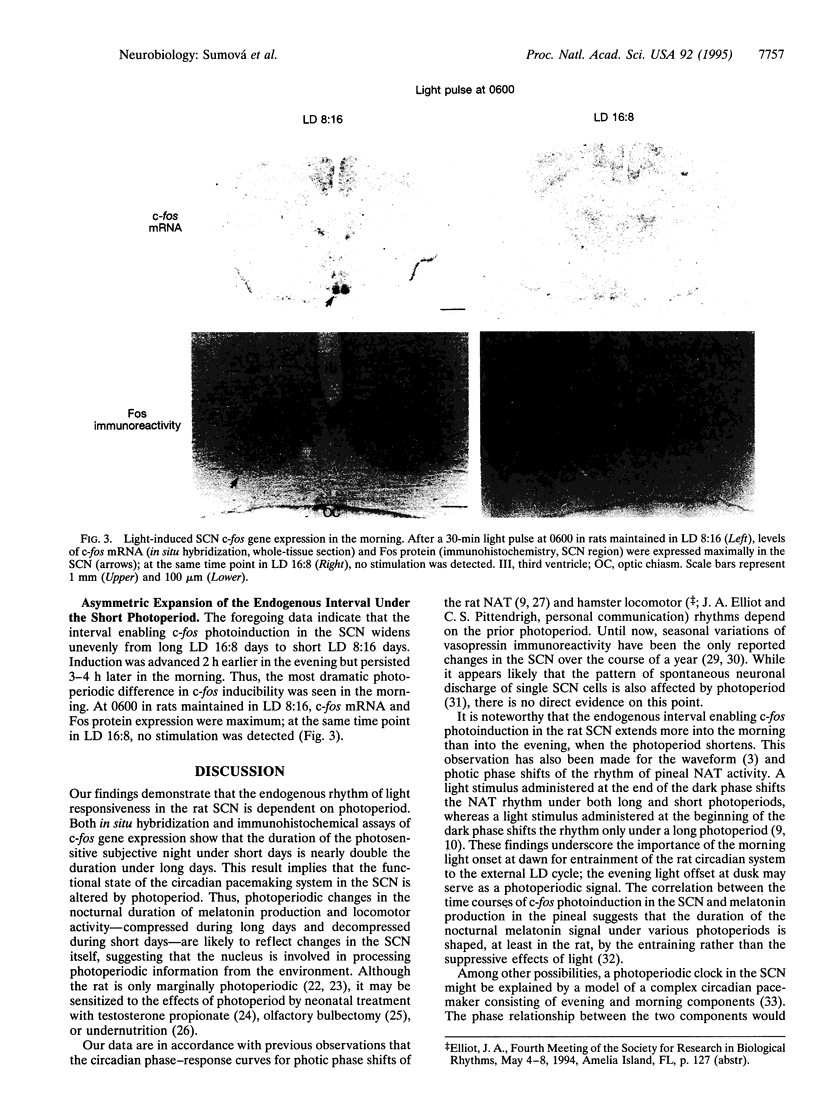
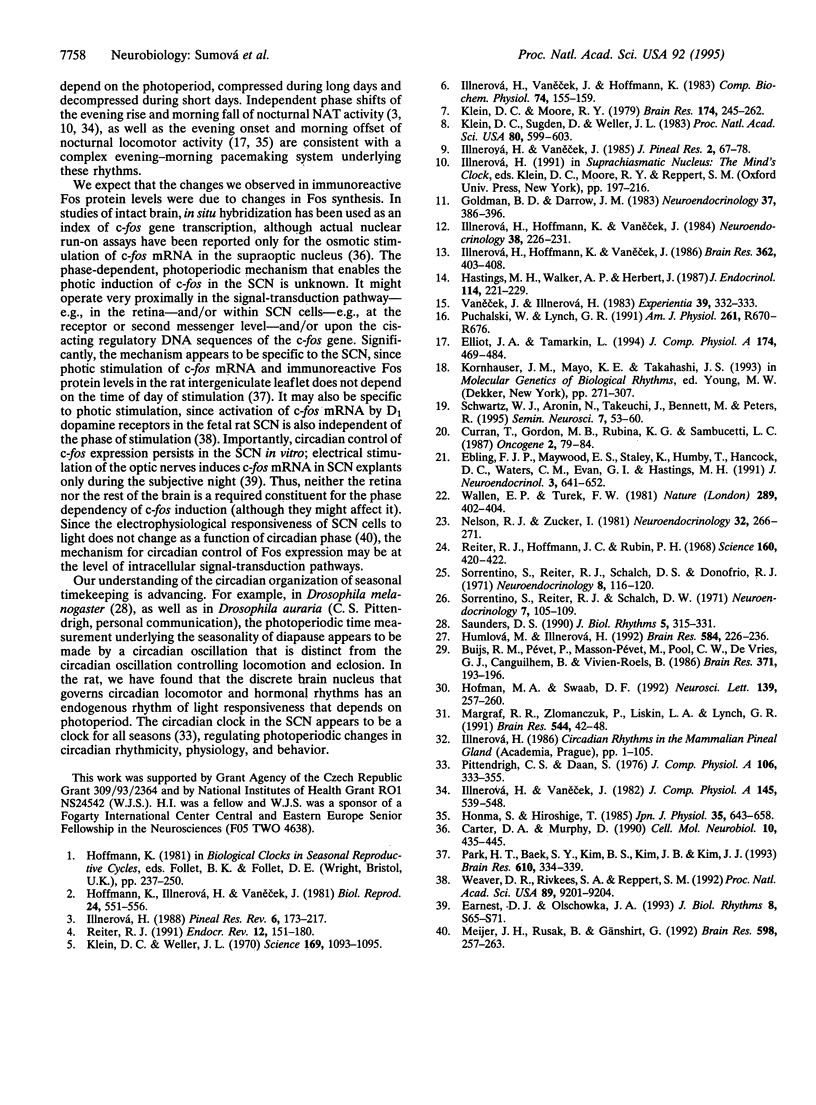
Images in this article
Selected References
These references are in PubMed. This may not be the complete list of references from this article.
- Buijs R. M., Pévet P., Masson-Pévet M., Pool C. W., de Vries G. J., Canguilhem B., Vivien-Roels B. Seasonal variation in vasopressin innervation in the brain of the European hamster (Cricetus cricetus). Brain Res. 1986 Apr 16;371(1):193–196. doi: 10.1016/0006-8993(86)90829-2. [DOI] [PubMed] [Google Scholar]
- Carter D. A., Murphy D. Regulation of c-fos and c-jun expression in the rat supraoptic nucleus. Cell Mol Neurobiol. 1990 Sep;10(3):435–445. doi: 10.1007/BF00711185. [DOI] [PMC free article] [PubMed] [Google Scholar]
- Curran T., Gordon M. B., Rubino K. L., Sambucetti L. C. Isolation and characterization of the c-fos(rat) cDNA and analysis of post-translational modification in vitro. Oncogene. 1987;2(1):79–84. [PubMed] [Google Scholar]
- Earnest D. J., Olschowka J. A. Circadian regulation of c-fos expression in the suprachiasmatic pacemaker by light. J Biol Rhythms. 1993;8 (Suppl):S65–S71. [PubMed] [Google Scholar]
- Elliott J. A., Tamarkin L. Complex circadian regulation of pineal melatonin and wheel-running in Syrian hamsters. J Comp Physiol A. 1994 Apr;174(4):469–484. doi: 10.1007/BF00191713. [DOI] [PubMed] [Google Scholar]
- Goldman B. D., Darrow J. M. The pineal gland and mammalian photoperiodism. Neuroendocrinology. 1983 Nov;37(5):386–396. doi: 10.1159/000123579. [DOI] [PubMed] [Google Scholar]
- Hastings M. H., Walker A. P., Herbert J. Effect of asymmetrical reductions of photoperiod on pineal melatonin, locomotor activity and gonadal condition of male Syrian hamsters. J Endocrinol. 1987 Aug;114(2):221–229. doi: 10.1677/joe.0.1140221. [DOI] [PubMed] [Google Scholar]
- Hoffmann K., Illnerová H., Vanecek J. Effect of photoperiod and of one minute light at night-time on the pineal rhythm on N-acetyltransferase activity in the Djungarian hamster Phodopus sungorus. Biol Reprod. 1981 Apr;24(3):551–556. doi: 10.1095/biolreprod24.3.551. [DOI] [PubMed] [Google Scholar]
- Hofman M. A., Swaab D. F. Seasonal changes in the suprachiasmatic nucleus of man. Neurosci Lett. 1992 May 25;139(2):257–260. doi: 10.1016/0304-3940(92)90566-p. [DOI] [PubMed] [Google Scholar]
- Honma K., Honma S., Hiroshige T. Response curve, free-running period, and activity time in circadian locomotor rhythm of rats. Jpn J Physiol. 1985;35(4):643–658. doi: 10.2170/jjphysiol.35.643. [DOI] [PubMed] [Google Scholar]
- Humlová M., Illnerová H. Entrainment of the rat circadian clock controlling the pineal N-acetyltransferase rhythm depends on photoperiod. Brain Res. 1992 Jul 3;584(1-2):226–236. doi: 10.1016/0006-8993(92)90899-k. [DOI] [PubMed] [Google Scholar]
- Illnerová H., Hoffman K., Vanecek J. Adjustment of the rat pineal N-acetyltransferase rhythm to change from long to short photoperiod depends on the direction of the extension of the dark period. Brain Res. 1986 Jan 8;362(2):403–408. doi: 10.1016/0006-8993(86)90473-7. [DOI] [PubMed] [Google Scholar]
- Illnerová H., Hoffmann K., Vanecek J. Adjustment of pineal melatonin and N-acetyltransferase rhythms to change from long to short photoperiod in the Djungarian hamster Phodopus sungorus. Neuroendocrinology. 1984 Mar;38(3):226–231. doi: 10.1159/000123895. [DOI] [PubMed] [Google Scholar]
- Illnerová H., Vanecek J. Entrainment of the circadian rhythm in rat pineal N-acetyltransferase activity under extremely long and short photoperiods. J Pineal Res. 1985;2(1):67–78. doi: 10.1111/j.1600-079x.1985.tb00628.x. [DOI] [PubMed] [Google Scholar]
- Illnerová H., Vanecek J., Hoffmann K. Regulation of the pineal melatonin concentration in the rat (Rattus norvegicus) and in the Djungarian hamster (Phodopus sungorus). Comp Biochem Physiol A Comp Physiol. 1983;74(1):155–159. doi: 10.1016/0300-9629(83)90727-2. [DOI] [PubMed] [Google Scholar]
- Klein D. C., Moore R. Y. Pineal N-acetyltransferase and hydroxyindole-O-methyltransferase: control by the retinohypothalamic tract and the suprachiasmatic nucleus. Brain Res. 1979 Oct 5;174(2):245–262. doi: 10.1016/0006-8993(79)90848-5. [DOI] [PubMed] [Google Scholar]
- Klein D. C., Sugden D., Weller J. L. Postsynaptic alpha-adrenergic receptors potentiate the beta-adrenergic stimulation of pineal serotonin N-acetyltransferase. Proc Natl Acad Sci U S A. 1983 Jan;80(2):599–603. doi: 10.1073/pnas.80.2.599. [DOI] [PMC free article] [PubMed] [Google Scholar]
- Klein D. C., Weller J. L. Indole metabolism in the pineal gland: a circadian rhythm in N-acetyltransferase. Science. 1970 Sep 11;169(3950):1093–1095. doi: 10.1126/science.169.3950.1093. [DOI] [PubMed] [Google Scholar]
- Margraf R. R., Zlomanczuk P., Liskin L. A., Lynch G. R. Circadian differences in neuronal activity of the suprachiasmatic nucleus in brain slices prepared from photo-responsive and photo-non-responsive Djungarian hamsters. Brain Res. 1991 Mar 22;544(1):42–48. doi: 10.1016/0006-8993(91)90883-w. [DOI] [PubMed] [Google Scholar]
- Meijer J. H., Rusak B., Gänshirt G. The relation between light-induced discharge in the suprachiasmatic nucleus and phase shifts of hamster circadian rhythms. Brain Res. 1992 Dec 11;598(1-2):257–263. doi: 10.1016/0006-8993(92)90191-b. [DOI] [PubMed] [Google Scholar]
- Nelson R. J., Zucker I. Photoperiodic control of reproduction in olfactory-bulbectomized rats. Neuroendocrinology. 1981 May;32(5):266–271. doi: 10.1159/000123171. [DOI] [PubMed] [Google Scholar]
- Park H. T., Baek S. Y., Kim B. S., Kim J. B., Kim J. J. Profile of Fos-like immunoreactivity induction by light stimuli in the intergeniculate leaflet is different from that of the suprachiasmatic nucleus. Brain Res. 1993 May 7;610(2):334–339. doi: 10.1016/0006-8993(93)91419-s. [DOI] [PubMed] [Google Scholar]
- Puchalski W., Lynch G. R. Circadian characteristics of Djungarian hamsters: effects of photoperiodic pretreatment and artificial selection. Am J Physiol. 1991 Sep;261(3 Pt 2):R670–R676. doi: 10.1152/ajpregu.1991.261.3.R670. [DOI] [PubMed] [Google Scholar]
- Reiter R. J., Hoffman J. C., Rubin P. H. Pineal gland: influence on gonads of male rats treated with androgen 3 days after birth. Science. 1968 Apr 26;160(3826):420–421. doi: 10.1126/science.160.3826.420. [DOI] [PubMed] [Google Scholar]
- Reiter R. J. Pineal melatonin: cell biology of its synthesis and of its physiological interactions. Endocr Rev. 1991 May;12(2):151–180. doi: 10.1210/edrv-12-2-151. [DOI] [PubMed] [Google Scholar]
- Saunders D. S. The circadian basis of ovarian diapause regulation in Drosophila melanogaster: is the period gene causally involved in photoperiodic time measurement? J Biol Rhythms. 1990 Winter;5(4):315–331. doi: 10.1177/074873049000500404. [DOI] [PubMed] [Google Scholar]
- Sorrentino S., Jr, Reiter R. J., Schalch D. S., Donofrio R. J. Role of the pineal gland in growth restraint of adult male rats by light and smell deprivation. Neuroendocrinology. 1971;8(2):116–124. doi: 10.1159/000121999. [DOI] [PubMed] [Google Scholar]
- Sorrentino S., Jr, Reiter R. J., Schalch D. S. Interactions of the pineal gland, blinding, and underfeeding on reproductive organ size and radioimmunoassayable growth hormone. Neuroendocrinology. 1971;7(2):105–115. doi: 10.1159/000121958. [DOI] [PubMed] [Google Scholar]
- Vanecek J., Illnerová H. The effect of daily evening isoproterenol administration on reproductive organ growth in male rats treated neonatally with testosterone propionate. Experientia. 1983 Mar 15;39(3):332–333. doi: 10.1007/BF01955334. [DOI] [PubMed] [Google Scholar]
- Wallen E. P., Turek F. W. Photoperiodicity in the male albino laboratory rat. Nature. 1981 Jan 29;289(5796):402–404. doi: 10.1038/289402a0. [DOI] [PubMed] [Google Scholar]
- Weaver D. R., Rivkees S. A., Reppert S. M. D1-dopamine receptors activate c-fos expression in the fetal suprachiasmatic nuclei. Proc Natl Acad Sci U S A. 1992 Oct 1;89(19):9201–9204. doi: 10.1073/pnas.89.19.9201. [DOI] [PMC free article] [PubMed] [Google Scholar]



